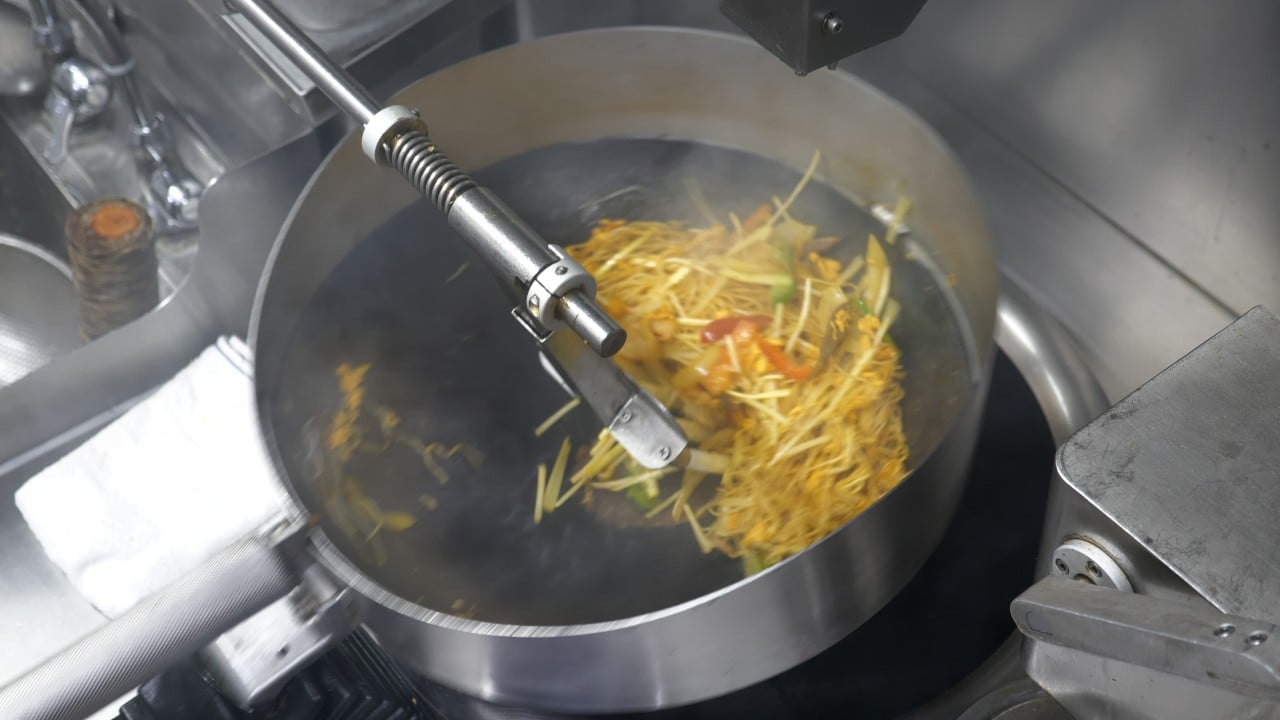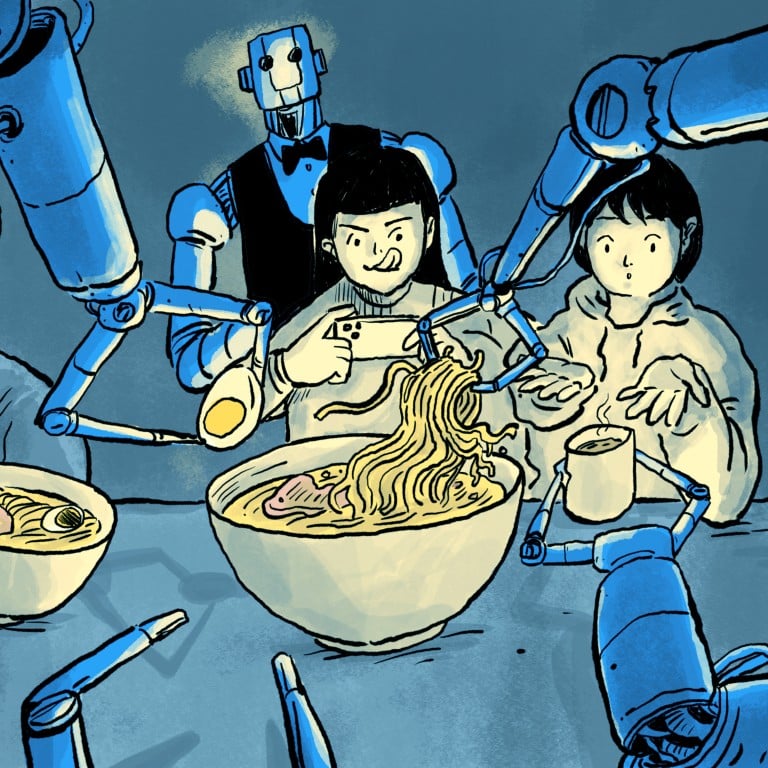
Rise of the robots … in dining and retail: Hong Kong’s restaurants, shops turn to technology to beat manpower crunch
- Automated woks rule in the kitchens of Tai Hing Group, with more than 200 outlets across the city
- Technology is raising efficiency, cutting costs and making up for lack of workers in retail industry too
In the kitchen of Hong Kong restaurant chain Tai Hing in Yuen Long, a chef stands ready to heed the commands from a large automated wok.
On cue, she adds salmon, cooked rice, eggs and chopped vegetables. The wok starts rocking, tossing everything together.
Within minutes, it stops and the chef starts dishing out plates of aromatic, colourful salmon fried rice.
“We’ve introduced a smart system in every outlet to make life more comfortable for the staff, especially the chefs, because their job is physically demanding,” said Jojo Chan Shuk-fong, the group’s executive director.
“It is getting very difficult to hire chefs. Young people back off as it is a tiring job that is not only extremely hard work, but also mentally and physically draining.”
The group began investing in technology hoping to attract new workers and retain its experienced staff.

Each outlet’s smart kitchen system costs about HK$700,000 (US$89,170) and has a variety of equipment to perform multiple tasks including poaching or roasting poultry, mixing barbecue pork sauce, and preparing milk tea.
Some outlets also use “Xiaodao” the robot to take cooked food from the kitchen to patrons at their table.
HK$500 million tech scheme gives young Hong Kong entrepreneurs a leg up
“This problem is killing us,” he said. “We are really worried that this will hamper the development of the industry.”
Aside from using QR codes for customers to scan menus and order, restaurants had taken to contactless payment and automated food processing machines.
Tai Hing Group’s Chan said using technology in the kitchen had not only improved efficiency and cut operating costs, but also helped the group maintain consistent food quality across all outlets, allowing it to expand.
Hong Kong ‘should fill tech void in China in bid to be country’s global I&T hub’
Retailers turn to tech too
Here too, technology is raising efficiency and making up for the lack of workers.
Visitors strolling through Central Market, the revitalised 82-year-old landmark on Des Voeux Road Central, may bump into a Novelte robot which speaks and provides guided tours, photos and information about the building’s architectural features.
The robot has helped to ease the shortage of customer service employees, said Angie Chung, the heritage spot’s general manager.

“All tenants with long-term contracts are installed with the POS here so they can keep track of the sales performance and product demand with the leasing team,” Chung said.
Hong Kong ‘must strengthen IP protections if hopes to become innovation hub’
She said the IoT was installed with sensors to detect potential problems such as water leakage, check air quality, humidity, sound and the capacity of rubbish bins.
“It allows us to detect potential accidents so that corrective or improvement actions can be carried out promptly,” she said.
Chung said the use of technology improved efficiency for tenants and saved manpower costs, as they did not have to rely on cashiers, for example.
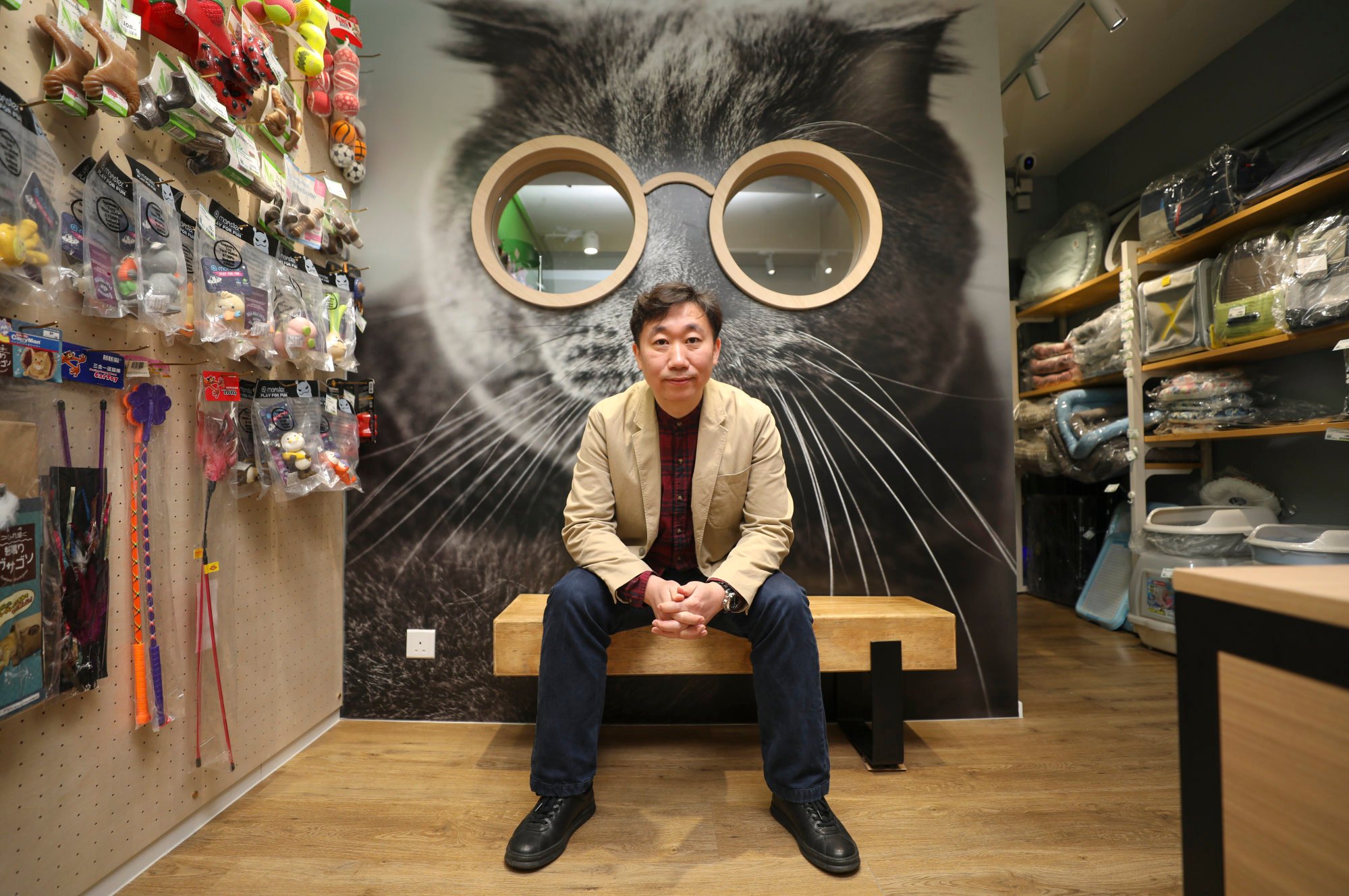
Kenny Lin Feng, 46, owner of pet food distributor Bark N Purr, runs Petwifi, a fully digitised round-the-clock retail store in Tsuen Wan.
He spent about HK$5 million to develop the technology needed for the 800-sq ft store which opened last September selling pet food and products.
Registered members enter the shop by scanning a QR code to open the door and shop. Lin has only one employee for the morning shift and at night, with no worker around, the entire operation is based on trust.
Hong Kong plays catch-up with schemes allowing e-payment across borders
“Customers come on their own, get the things they need and pay by themselves. This is a shop for pet owners promoting mutual trust between humans,” he said.
A centralised surveillance system allows Lin to monitor the shop and an automated system tracks inventory and accounts.
Hong Kong ranked ninth in global innovation hubs list, Singapore still at No 1
“There is a risk that we may lose our goods, but so far we haven’t had a single case of theft,” said Lin. “I strongly believe Hongkongers are very honest people with good qualities. That’s why I want to try out this concept of promoting trust in society.”
Customer feedback has been positive and the list of members has grown.
Encouraged by the experience, especially the improved efficiency despite having fewer workers, Lin said he hoped to apply the digitised system in new stores.
He also hoped to nudge other businesses to embrace technology too. “We hope to build a bigger pie out of this,” he said.
‘Government can do more for SMEs’
The Hong Kong government has various funds to support local businesses to use technology to upgrade their business operations and train their workers.
The Technology Voucher Programme, for example, approved 6,687 applications from the wholesale and retail industry last year, with total funding of about HK$1,135 million, and 1,610 applications from restaurants and hotels for about HK$244 million funding.
Lawmaker Peter Shiu Ka-fai, representing the retail sector, said many big retail chains faced a shortage of about 10 to 20 per cent, yet many were slow to take advantage of technology that could help.
More Hong Kong care homes are using robots
“The use of e-commerce platforms for online shopping can indeed save manpower, but many retailers such as small jewellery shops or boutiques can’t afford to install technological devices for e-commerce,” he said.
As of September last year, there were more than 63,000 retail outlets in Hong Kong with more than 245,000 workers.
Most Hong Kong online stores do not declare data is used for AI models training
Shiu urged the government to either provide more funding support for small businesses to adopt technologies or bring in foreign labour.
“If outlets don’t have enough staff to serve customers, it will be a blow to the city’s competitiveness and impede its economic recovery,” he said.
Angie Chung of the Central Market agreed, saying: “It is undeniable that technology can help boost efficiency, by saving costs and increasing efficiency. More funding can absolutely motivate the sector to adopt technology.”
A smarter way in the kitchen
A government subsidy of HK$700,000 helped catering veteran Arist Wong Chi-chiu switch from running restaurants to developing a smart food manufacturing system last year.
“The restaurant business is a very tough business – long working hours, no holidays and you have to stand for a long time. Nowadays no young people are willing to join this industry and we have an ageing workforce,” he said.
During the pandemic, he decided to start a food factory and central kitchen in Tuen Mun.
His 3,000-sq ft smart kitchen cost more than HK$2.3 million to set up, and the government subsidy helped.
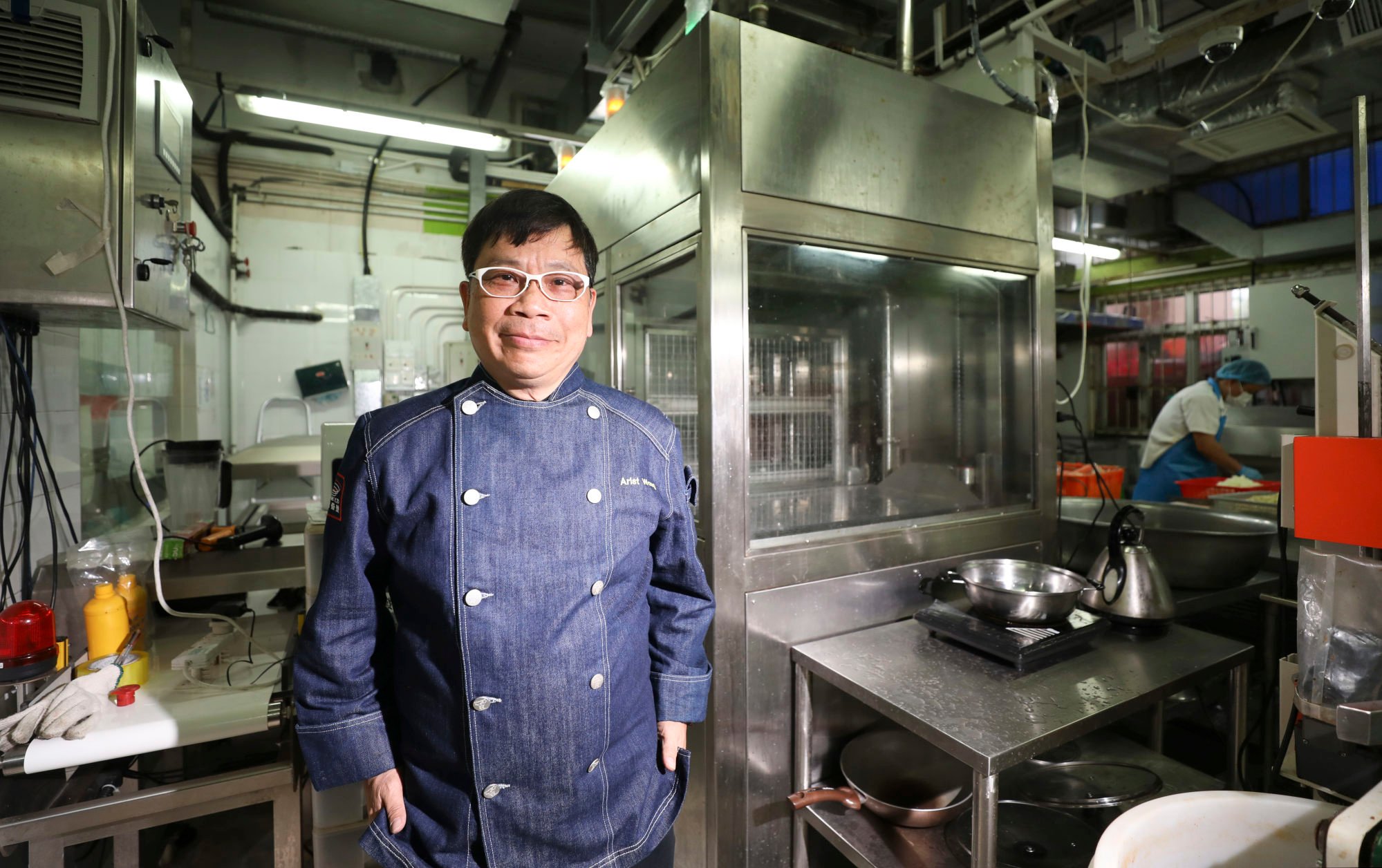
Using sous vide equipment, it produces about 1,000kg of pre-cooked and pre-packaged food daily, supplying about 20 restaurants which have 5,000 patrons a day.
Sous vide is a slow-cooking process in which marinated food is vacuum sealed in a bag before being cooked in a water bath at a consistent temperature.
The smart system ensures precise temperature controls and evenly cooked food sealing in all the natural flavour and nutrition.
The kitchen turns out everything from braised beef brisket to lamb stew, steaks, pork knuckle, pork ribs, pork belly, chicken breast, chicken wings and soup.
Small portions of food are frozen before delivery to the restaurants, which only need to heat and plate the food when their customers want it.
Over HK$16 billion earmarked to turn Hong Kong into key innovation, technology hub
Wong said the quality was no different than if the food was freshly cooked at the restaurant.
Wong estimated the smart system could raise efficiency and his profit margins while saving manpower costs.
Instead of hiring 14 people in the past for one restaurant kitchen, he now has only eight workers to operate the smart kitchen.
“Managing machines is better and easier than managing a group of people,” he said. “We don’t need any chefs. We just need people to operate the machines.
“This kind of smart food production saves a lot of space for cooking and storing food. It also reduces food wastage as you only reheat the required portions when needed.”
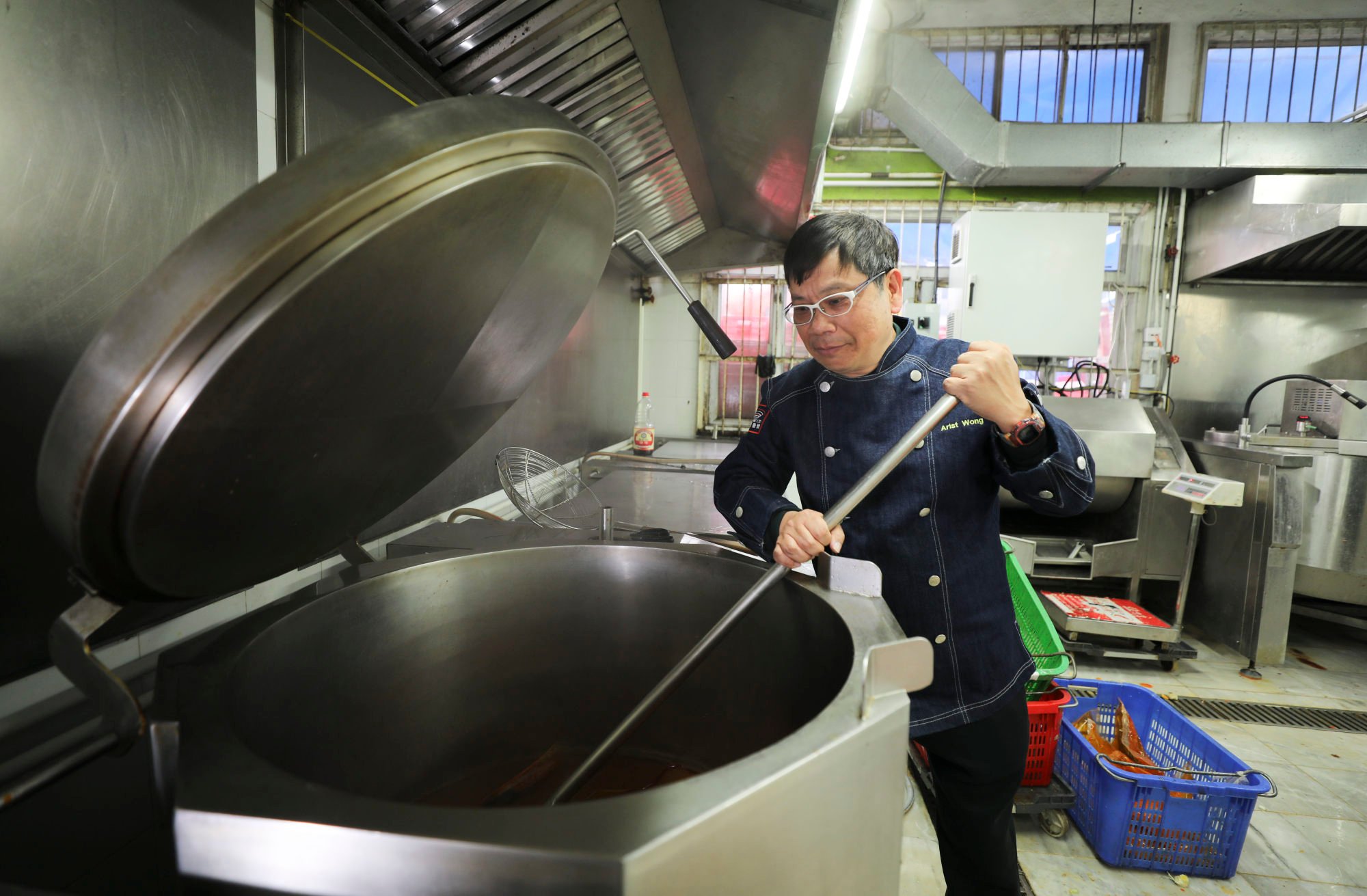
Wong’s digital order management system helps to optimise production and delivery arrangements, reducing waste that can result from producing more than is needed.
As founding chairman of the Hong Kong Smart Catering Association, he said he hopes to push the government to provide more support for the industry.
“We need to adopt new technology to entice young blood and cope with the manpower shortage. I also hope to help other industry players to set up a smart system like mine,” Wong said.


